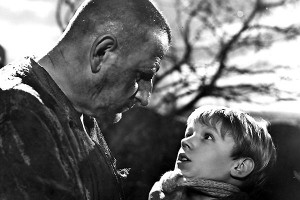The great director Sir David Lean is remembered mainly for lushly coloured 70mm epics with big international casts, sweeping stories and long running times (e.g., Lawrence of Arabia, A Passage to India, Bridge on the River Kwai, Dr. Zhivago). But he had a fine career before those triumphs during which he made tightly constructed black and white films with British casts, stories and locations. These early Lean films include two excellent Dickens’ adaptations, one of which is this week’s recommendation: The 1946 version of Great Expectations.
The origins of Lean’s adaptation of the oft-filmed novel are visible in a film I recommended a few months back: In Which We Serve. Lean was an accomplished film editor when he got a chance to break into directing alongside Noël Coward on that movie. The cinematographer Ronald Neame is the producer of Great Expectations (and likely an influence on Guy Green’s trendsetting camera work). Bernard Miles and John Mills are back as actors, again adroitly playing off each other with emotional impact. Kay Walsh goes from acting to collaborating with Lean on the screenplay (along with Neame, Anthony Havelock-Allan, and Cecil McGivern), a masterpiece of economy which relates the story of Charles Dickens’ 500-page novel in just 118 minutes. Walsh went on to star in Lean’s excellent Oliver Twist and in private life to become the second in his series of six wives (imagine the alimony payments!). Alec Guinness was not in In Which We Serve, but Great Expectations, his first sizable film role, began his long-running cinematic partnership with Lean. All of this demonstrates what a small community British film was in its glorious period after the war, and the even smaller nature of the network Lean constructed around his own projects.
 I will not bother to summarize the plot of such a well-known novel, which I assume you have read (If not, stop wasting your life reading what I write and pick up Dickens instead). Although of course Boz didn’t write for the movies, his storytelling style, vivid characters and scene construction lend themselves very well to movie making. It is therefore no wonder that so many filmmakers have adapted his novels. Lean’s Great Expectations I believe is the 4th of at least 10 film versions of the book.
I will not bother to summarize the plot of such a well-known novel, which I assume you have read (If not, stop wasting your life reading what I write and pick up Dickens instead). Although of course Boz didn’t write for the movies, his storytelling style, vivid characters and scene construction lend themselves very well to movie making. It is therefore no wonder that so many filmmakers have adapted his novels. Lean’s Great Expectations I believe is the 4th of at least 10 film versions of the book.
As we expect of the British films of this period, there are no poor performances, even in the smallest roles. In one of the most stunning acting turns ever by a teenager, Jean Simmons is bewitching as the heartless Stella. Guinness radiates charm and nascent star power as Herbert Pocket and Martita Hunt is arguably the most memorable Miss Havisham in cinema history. John Mills is way too old to play Pip as adult, but he gives it a pretty good go. I also particularly liked Miles as the simple, honourable Joe Gargary, Finlay Currie as the convict Magwitch and Francis L. Sullivan as the smooth-as-silk solicitor Jaggers, a role he also played in the 1934 Universal Studies version of the film.
The art direction and set design are inspired, particularly Miss Havisham’s creepy house, the scenes of Victorian London city life, and the opening sequence in the church graveyard. Guy Green accentuates the mood by using many low-level shots, helping us appreciate the child’s point of view through which the story is told. As he went on to do in Lean’s Oliver Twist in 1948, Green uses lighting and camerawork to create a mood that at times is as much appropriate to horror as to drama. He won Britain’s first Oscar for cinematography for Great Expectations, and was a major influence on a number of top-drawer cinematographers in subsequent decades. That’s just one of many reasons not to miss this beloved classic film adaptation of a beloved classic novel.